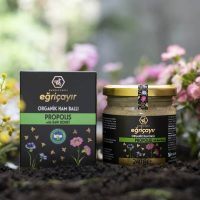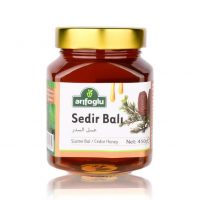Beeo – Bee Bread, 3.17oz – 90g
$62.99
Just like humans, bees add their enzymes to the pollen they gather from nature and store them in honeycomb eyes and make their own breads. This is the first food of the bee. Bee bread is the outer membrane of the pollen digested by the bee’s own enzymes, revealing all its nutrient content and higher digestibility by humans. In the composition of bee bread; protein, carbohydrates, fiber and fats, as well as vitamins (Niacin (B3), Pyridoxine (B6), Thiamine (B1), Riboflavin (B2), Pantothenic acid (B5), Folic acid, Biotin (H)), Tocopherol (E) Ascorbic acid (C), Beta carotene mineral substances (Potassium (K), Calcium (Ca), Magnesium (Mg), Zinc (Zn), Iron (Fe), Copper (Cu), Manganese (Mn), Phosphorus P) There are many biologically active substances such as phenolic substances, flavonoids, polyphenols, amino acids, fatty acids and organic acids.
This was done because the bee sharing first day in May in Turkey and in the world after China, we have noted that beekeeping is the 2nd largest country. The nutritional values of bee products produced in the unique geography of Anatolia rank first in the world. Indeed, especially in Anatolia Anatolia raw honey and propolis, named Turkey’s critically began to be talked about by many different bee products. In this context; We will examine Bee’o brand’s Bee Bread product, which has received innovation awards from many reputable organizations around the world and increased the number of national and international awards to 32. In this share, we will also present analysis data on Bee Bread that you cannot find anywhere else.
What is Bee Bread?
First of all, perhaps the product that is foreign to many people; It is necessary to mention Bee Bread. Bee bread is a bee product, also known as Perga. It can be defined as the fermented form of pollen by bees. So much so that bee bread is the state in which the outer membrane of pollen in flowers is digested by the bee’s own enzymes and all nutrient content is released. Originally; The disintegration of the membrane by enzymes is a fermentation process and beneficial bacteria develop in this fermentation. In this respect, bee bread has probiotic properties.
There are Lactobacillus bacteria in the composition of bee bread. These bacteria are also found in yogurt, one of the most beneficial probiotic foods. Again, yoghurt, a traditional food of Anatolia, and bee products produced in the unique geography of Anatolia are actually a source of healing for all of us. Probiotics are the basis of this healing resource.
Bee bread is not only for its probiotic properties; It also draws attention with its protein, vitamin and mineral content. So much so that Bee bread contains many vitamins and minerals as well as high protein. In bee bread, respectively; There are vitamins A, B1, B2, B3, B6, B12, C, E, D and K. In addition, it contains minerals such as Phosphorus, Potassium, Calcium, Sodium, Magnesium, Iron and Zinc. It also contains Folic acid and Carotene. You can find more information about Bee Bread Perga from the scientific resource below. ITU approved analysis report data is also presented below.
Energy 246 kcal
Carbohydrate 35 gr.
Protein 21 gr.
Phosphorus 530 mg.
Potassium 58 mg.
Calcium 225 mg.
Zinc 8.7 mg.
Copper 1.4 mg.
Iron 14 mg.
Nickel 0,45 mg.
B1 vitamin 0.94 mg.
B3 vitamin 15.7 mg.
B2 vitamin 1.86 mg.
B6 vitamin 0.9 mg.
B5 vitamin 2.8 mg.
Folic acid 0.52 mg.
Biotin 0.03 mg.
C vitamin 35 mg.
9,5 mg of carotene.
Note: Nutritional Values in 100 grams are given.
Where can I buy Bee Bread?
We are selling one of the best bee bread in the market with express shipping.
Brand
Beeo
All the orders are shipped from Turkey via DHL. We are happy to work with a well-known shipping company.
We ship worldwide by DHL and we will inform your tracking number immediately after your order is shipped.
The preparation time is between one to four working days. The preparation time may be longer for hand made products. Those products are specifically produced for you and it is generally 7 days. If it is longer than 7 days, the details can be found in the description section of the product page.
There are two options for delivery. The first one is DHL Express and it is the faster option. Your order will be at your shipping address between 1 day to 7 days. Details are listed at the bottom. The second option is Normal shipping. Delivery time takes between 25 days to 30 days for Normal shipping. If you are not in a hurry you can always prefer this method.The shipping cost is calculated by the total price of your order. If your cart total is greater, the shipping cost will be lesser. You will earn free shipping when your order total is over 100$.
Estimated delivery times for DHL Express Shipping:
- UK: 1-3 days
- Europe: 1-3 days
- U.S.A and Canada: 2-4 days
- Middle East: 2-4 days
- South America: 2-5 days
- Rest of the World: 2-7 days
Estimated delivery times for Normal Shipping:
- All over the World: 25-30 days
For more information about our delivery service please check here.








